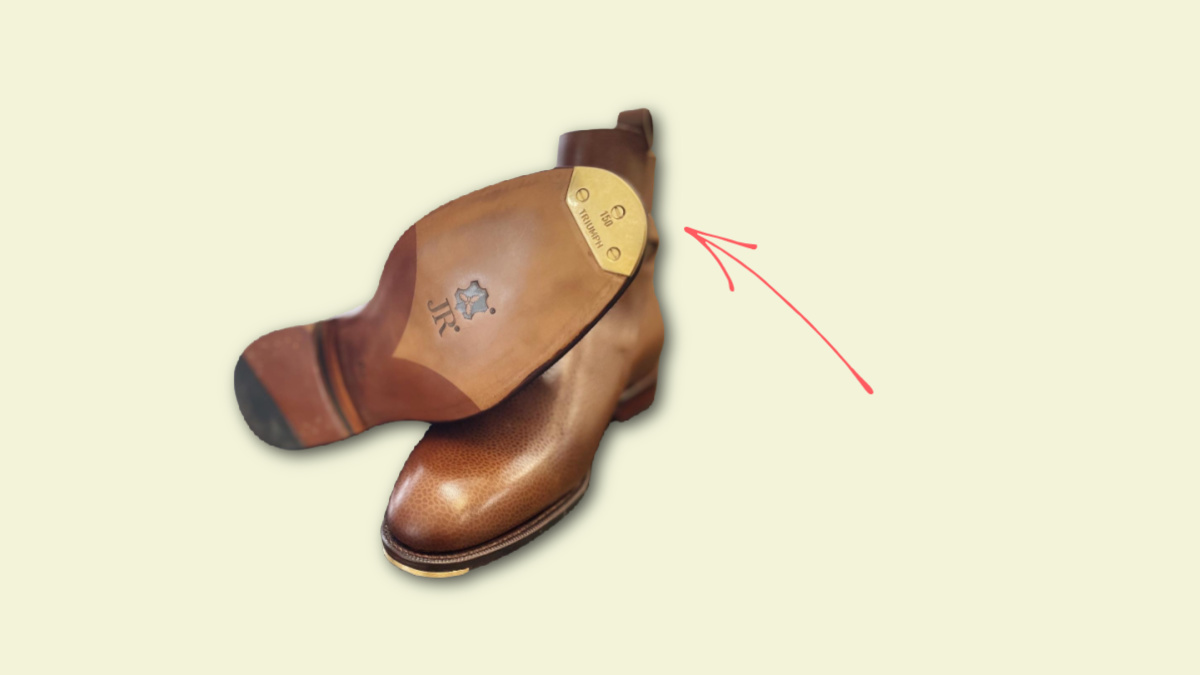Toe taps, otherwise known as shoe taps, are metal plates inserted onto the bottom toe edges of leather outsoles. A cobbler carves a smooth crevice in that area so the tap can sit flush. This protects your outsole from premature wear and extends the life of your dress shoes.
Toe taps are to shoes like what bay leaves are to cooking.
Stay with me. I have a point.
A lot of people think both are unnecessary, useless even. However, just as a (good) bay leaf subtly transforms the flavor of a dish, toe taps add to the longevity of your dress shoes. You only notice the difference once they’re there.
Since I know way more about shoes than I do cooking, I will explain exactly what toe taps are and why they’re an important part of footwear upkeep.
Table of Contents
What Are Toe Taps?
Toe taps, also known as shoe taps, are metal plates placed at the toe of your dress shoe’s leather outsole. They’re sometimes made of rubber and, less commonly, plastic. A layer of the foremost bottom part of the outsole’s toe is removed, then replaced with this metal plate via screws. It sits flush in the gap made by the portion removal.
The point of shoe taps is to protect the toe area, which is commonly where premature wear starts. This extends the life of your outsoles, keeping the inevitable, eventual need for resoling as far away as possible.
Remember my bay leaf analogy? Well, just as you want to stick to good bay leaves, not the kind that has been sitting in the pantry for months, you want to stick to good toe taps.
And by good toe taps, I’m referring to metal ones. Those who think toe taps are useless are likely ones who aren’t using the right kind.
There Are Two Types of Toe Taps
Beyond the different materials they can be made of (though we only care about metal ones), there are two shapes of toe taps. The primary makers are Lulu or Triumph, and most cobblers will carry either or both.
A Lulu toe tap is shaped like a semi-circle. This means that, with the rounded tip aside, it’s one-sided, with a straight line from one end of the sole to the other.
A Triumph toe tap has one rounded side for the toe. The other side is like the top of an isosceles trapezoid, meaning it’s three-sided. So unlike the Lulu toe tap, which features a straight line from one end to the other, the non-toe side of a Triumph tap has a sort-of tipless triangle jutting out.
Triumph and Lulu are the main toe tap makers in the industry, with their respective associated tap shapes. Of course, you can find generic brands that make similar-shaped toe taps as well.
Both shapes are of equal quality, so it’s really more of an aesthetic choice. The Triumph toe tap is slightly more challenging to install since the extra sides require more nuance when cutting out part of the sole and requiring more screws.
However, for a skilled cobbler, this is pretty inconsequential.
What Are Heel Taps?
Heel taps, also known as heel plates, heel guards, or heel savers, serve the same purpose as toe taps, except they go on the heel. Similarly, they’re often made out of metal or rubber.
They go right at the outside edge of the heel, just a bit towards the outer part from the center. So, it would be center left on your left, and center right on the right. That’s where your initial point of impact is per shoe. If you look at the heel of a shoe you just walked around in, those parts of the edge will be more scuffed.
Unlike with toe taps, you don’t carve out a section of the heel though.
And unlike toe taps, which are highly recommended, heel taps are only worth it with cheap shoes you’ll kick around in a lot.
With a well-made leather-outsoled dress shoe, the heel is pretty fortified. It’s not the place where premature wear starts. In fact, a lot of dress shoes these days feature a rubber heel cap.
Style-wise, many believe that heel taps cheapen the look of a good shoe.
How are Toe Taps Installed?
A professional cobbler will start by placing the tap at the toe edge of the bottom of your shoe, then tracing its shape with a sharp pencil. This is the part he’ll chop off.
Using a metal-edged implement, he’ll cut away at this area. He’ll only go as deep as the height of the toe tap he’s using so it can sit flush in that section. Most importantly, he’ll take care not to disrupt the stitching at the edge of the shoe — this is the part that takes a truly deft hand.
Then, he’ll make sure he went deep enough by placing the tap in the newly-made crevice. He’ll use small screws to secure it if it sits flush. Otherwise, he’ll keep chipping away at it.
And finally, he’ll sand all of the edges down to ensure everything is clean, uniform, and uninterrupted.
Should You Consider Getting Toe Taps for Dress Shoes?
If you have traditional leather dress shoes with traditional leather outsoles, that’s the first prerequisite. They’re not worth it for hybrid dress sneakers, for example. You absolutely can install toe taps on rubber outsoles, but the toe isn’t particularly sensitive to wear on rubber as it is on leather.
Second, if you’re looking at an older shoe, look at the level of wear on the outsole already. If there’s less than half of it left, then you’re better off just getting it resoled. For most shoes, that’s around the time to do it. Otherwise, you definitely aren’t too far off from the time to resole.
If you have more than 50% of your soles left, then go ahead and get some taps installed.
Another reason to get taps? If you only own one leather-soled dress shoe. If, say, you’re usually a sneaker guy, but you invested in one really high-quality pair of Oxfords that’s your go-to for all formal occasions, taps are a good idea.
More importantly, go for shoe taps if you’re a suit guy who only has one pair of dress shoes you wear daily (though if that’s your lifestyle, I recommend investing in at least one more pair. Loafers, maybe).
And finally, if you walk on various surfaces in your dress shoes, you’re likely putting them through a lot of different kinds of impact.
This is the case with me.
I wear a suit and dress shoes to work every day. I also live in New York City, and work at an art gallery. I’m going from my apartment’s hardwood floors, to the marble stairs of my lobby, to a ten-minute walk on Manhattan’s concrete floors, to the marble lobby of my office. From there, I’m going back and forth between my carpeted back office and the concrete gallery floors all day long.
If you have even half of that kind of lifestyle, I recommend taps.
The Benefits of Toe Taps
With leather outsoles, the toe tends to wear down faster than the rest of the construction.
If you wear dress shoes every day, or if you’re putting them through a variety of different surfaces like I do, you might find that the toe gets fully worn, way past the stitching, while the heel is still fully intact.
I think having to completely resole a shoe when 90% of the outsole is still perfectly usable is incredibly discouraging, a waste of money, and a waste of leather.
You get the most out of your dress shoes by protecting the weakest link.
Also, many agree that a metal toe tap adds a more put-together aesthetic to your shoe. Okay, so most people won’t even see that it’s there, but it’s the kind of detail the discerning love to see, similar to seeing real welt-stitching.
Potential Drawbacks of Toe Taps
Truthfully, there aren’t any real drawbacks to good toe taps.
Plastic toe taps will protect your shoes just fine, but they’ll wear out quickly. I liken it to buying a cheap phone screen protector. Sure, it’ll serve as a proper forcefield for your screen, but drop it once, and you’ve got cracks on that protective layer, and it’ll need replacing.
Moreover, plastic toe taps aren’t usually designed to sit flush in the sole, meaning you don’t need to cut that piece of leather off. It can make it slightly uncomfortable, off-balanced, and unsightly for some people.
There’s also the matter of noisy toe taps. Again, this won’t be an issue if it’s properly installed and properly sanded down.
And if it’s properly installed, this will prevent the metal tap from scratching up any floors. The only situation in which this can happen is if the cobbler didn’t fully ensure the tap was flush.
Tap Into Quality
If you’re new to nice shoes and are considering finally investing in that full-grain leather, Goodyear-welted shoe you’ve been eyeing, you might also want to see if your local cobbler does toe taps — fortunately, most do.
Or, if you already have a nice go-to pair or several, raid your closet and look at those outsoles. It may very well be time to get them tapped.
FAQs
Should I put taps on my dress shoes?
If you have proper dress shoes with traditional leather outsoles and they aren’t more than halfway worn down, toe taps are a worthwhile addition. They’ll extend the life of your shoes. If they’re more than halfway worn down, then waiting until it’s time to resole is a wiser option.
Are toe taps on dress shoes noisy?
No. Toe taps do not make your shoes noisy. Properly installed toe taps sit flush in your sole, and won’t make any substantial noise.
How do you put taps on dress shoes?
A cobbler will cut out a piece of the bottom of your shoe, at the toe edge, where the tap goes. Then he’ll place the tap flush in that crevice, screw it in, then sand down the outer edges, ensuring a smooth finish.


Join the Discussion